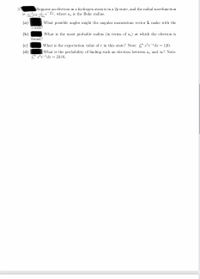Question
thumb_up100%

Transcribed Image Text:3.
Suppose an electron in a hydrogen atom is in a 2p state, and the radial wavefunction
e 2ao, where a, is the Bohr radius.
1
is
(2ао)3/2 VЗа.
(а)
What possible angles might the angular momentum vector L make with the
Z-axis?
(b)
What is the most probable radius (in terms of a.) at which the electron is
found?
(c)
What is the expectation value of r in this state? Note: S xe-"dx
120.
(d)
What is the probability of finding such an electron between a, and ∞? Note:
° x*e-"dx = 23.91.
Expert Solution
This question has been solved!
Explore an expertly crafted, step-by-step solution for a thorough understanding of key concepts.
Step by stepSolved in 5 steps with 4 images

Knowledge Booster
Similar questions
- An electron is in an f state. Can it undergo a quantum jump to an s state? A p state? A d state? Explain.arrow_forward4..arrow_forward7. One electron is trapped in a one-dimensional square well potential with infinitely high sides. a. If you have a probe that has a width for electron detection Ax = 0.00350L in the x direction, for the first excited state ( n =2), what is the probability that the electron is found in the probe when it is centered at x = L/4, (hint: you can use an approximation for this - you do not need to do an integral)? b. What is the average number of electrons that you would detect using the probe described in part "b." centered at x = L/4, ifthe electron is in the first excited state (n = 2) for each experiment and you repeat the experiment N, =100,000 times?arrow_forward
- Which of the following sets of quantum numbers n, l, and m¡ would be possible for an excited state of hydrogen? (circle yes or no) I. n= 4, 1= 2, mị II. n= 3, 1=2, m¡ = -2 П. п %3D 2, 1%32, т) %3D+1 IV. п %3D17, 1 %3 2, т %3 —2 =-3 Yes/No Yes/No Yes/No Yes/Noarrow_forwardPlease answer (i), (v), and (vi). Thank you! (i) Using Bohr model for atomic hydrogen, obtain energy levels for the 2s, 3s and 3p states in the actual number with the unit of [eV]. We consider a transition that electron in the 3p state emits a photon and make a transition to the 2s state. What is the frequency v of this photon ? (ii) Now we do not include electron spin angular momentum, and just estimate an effect of a magnetic field B on this transition (Normal Zeeman effect) with orbital angular momentum. How many lines of optical transition do we expect ? What is the interval of the frequency in the field B = 0.1 Tesla ? (iii) In this situation, we do not expect transition from 3s to 2s state if the electron is initially in the 3s state, Explain the reason. (iv) We now consider an effect of magnetic field B to a free electron spin (not in Hydrogen, but a free electron). The magnetic field of B = 1.0 Tesla will split the energy level into two (Zeeman) levels. Obtain the level…arrow_forwardPhysics 1. Derive the expression ε(ω)=1- ωp 2 / ω2 , ωp2 =ne2 /ε0m for the dielectric constant as a function of ω for a free electron gas of number density n. 2. Show clearly that metals are opaque to light for which ω is less than ωp. 3. Calculate the wavelength cutoff for Na metal if the volume of a primitive unit cell in Na is 35×10-30 m3 how to solve this problem?arrow_forward
arrow_back_ios
arrow_forward_ios